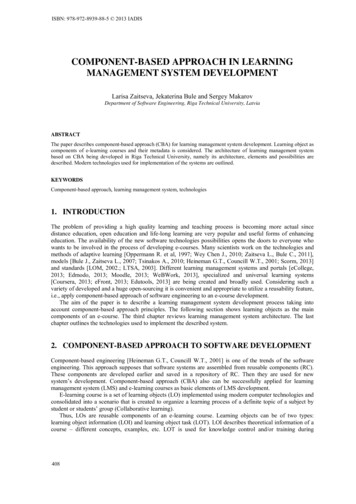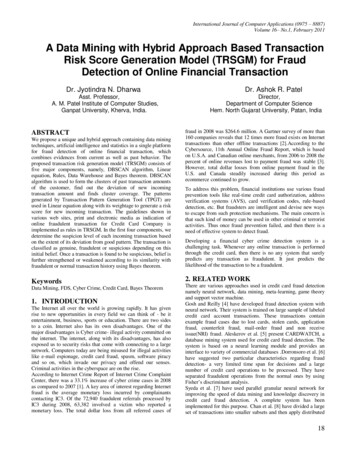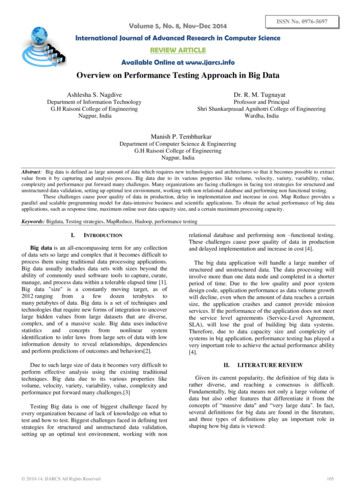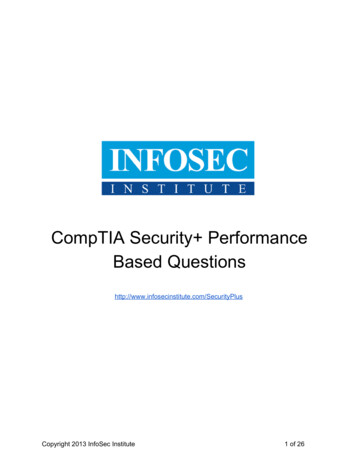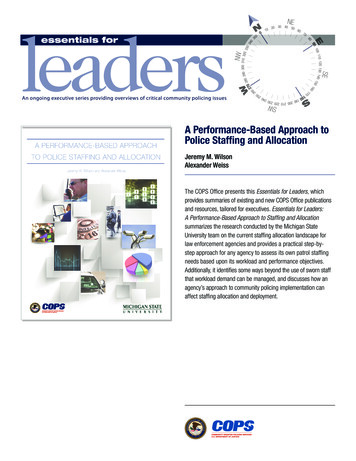
Transcription
An ongoing executive series providing overviews of critical community policing issuesA Performance-Based Approach toPolice Staffing and AllocationJeremy M. WilsonAlexander WeissThe COPS Office presents this Essentials for Leaders, whichprovides summaries of existing and new COPS Office publicationsand resources, tailored for executives. Essentials for Leaders:A Performance-Based Approach to Staffing and Allocationsummarizes the research conducted by the Michigan StateUniversity team on the current staffing allocation landscape forlaw enforcement agencies and provides a practical step-by step approach for any agency to assess its own patrol staffingneeds based upon its workload and performance objectives.Additionally, it identifies some ways beyond the use of sworn staffthat workload demand can be managed, and discusses how anagency’s approach to community policing implementation canaffect staffing allocation and deployment.
2A Performance-Based Approachto Police Staffing and AllocationThis project was supported by Grant Number 2009-CK WX-K005 awarded by the Office of Community OrientedPolicing Services, U.S. Department of Justice. The opinionscontained herein are those of the author(s) and do notnecessarily represent the official position or policies of theU.S. Department of Justice. References to specific agencies,companies, products, or services should not be consideredan endorsement by the author(s) or the U.S. Department ofJustice. Rather, the references are illustrations to supplementdiscussion of the issues.The Internet references cited in this publication were valid asof the date of this publication. Given that URLs and websitesare in constant flux, neither the author(s) nor the COPS Officecan vouch for their current validity.PrefaceMuch attention has been given to police recruitment,retention, and how to maintain police budgets andexisting staffing positions. Less has centered onadequately assessing the demand for police service andalternative ways of managing that demand. To providesome practical guidance in these areas, the Office ofCommunity Oriented Policing Services (COPS Office)provided support to the Michigan State University(MSU) School of Criminal Justice to review current lawenforcement staffing allocation experiences and existingapproaches to estimating the number of sworn staff agiven agency requires.This document provides an executive summary of theresearch conducted by the MSU team. It highlights thecurrent staffing allocation landscape and a practicalapproach for any law enforcement agency to assess itsstaffing needs based upon its workload and performanceobjectives. It also highlights some ways beyond the useof sworn staff that workload demand can be managed,and discusses how an agency’s approach to communitypolicing implementation can affect staffing allocationand deployment. This work illustrates the issues policepractitioners and planners must consider in conductingan assessment of their agency’s staffing need. It shouldalso be of particular interest to police executives andpolicymakers who are concerned about both policestaffing allocation and efficiently providing qualitypolice services in their communities.This research is more fully documented in APerformance-Based Approach to Police Staffing andAllocation. In addition to the above audiences, thatwork should be of interest to researchers interested inpolice staffing experiences and assessment methods.The Current Context for PoliceStaffingStaffing police departments is a continuous challengethat has become more complex in recent years. For sometime, agencies have struggled to balance their efforts inrecruiting and retaining their officers. These challengeswere exacerbated by the recession of late 2008 and early2009, which caused police agencies to implement hiringfreezes, furloughs, lay-offs, salary and benefit cut-backs,and retirement incentives.
3Such challenges have made it more imperative to answerthe fundamental question of staffing analysis: How manypolice officers does an agency need? Answering thisquestion is essential to any discussion about managingworkforce levels, regardless of whether there is a shortageof qualified officers or an inability to support previousstaffing levels.obligating fewer officers to do more work. Interviewswith representatives of police agencies suggest that therecession of late 2008 and early 2009 exacerbated thesetrends, with resources becoming so scarce that agenciesoften cannot apply innovative solutions learned elsewherebecause they are struggling to maintain even basic levelsand forms of service.Ultimately, police decision-makers have few resourcesto guide them in determining the number of officersthey need. To be sure, there are multiple approaches toanswering this question, but these generally have not beendescribed and synthesized in a way that most practitionerscould immediately understand and implement. This workoutlines one approach to determining workforce need.Interviewees reported a wide range of internal andexternal determinants of staffing need, including efficiencyand productivity, crime rates, job tasks and calls, officerto-population ratios, and established minimum staffinglevels. Most agencies perform staffing analyses, but theirlevel of sophistication varies. Agencies cite many differentreasons for conducting analyses, including organizationaland leadership change and for budgeting and negotiationpurposes. Many staffing benchmarks reflect determinantsof staffing need.Several sources of information and expertise guide thisapproach. First is literature on police staffing analyses,including staffing tools and manuals, case studies,consultant assessments, and academic studies. Secondare results from interviews with representatives from 20different agencies of varying size, region, and jurisdiction.Third are results from a focus group with 21 policeexecutives and planners, researchers, consultants, andmembers of the U.S. Department of Justice, Office ofCommunity Oriented Policing Services (COPS Office).Fourth is the practical and academic experience theresearch team for this project has in working with policeagencies across the United States in assessing staffingneeds, identifying areas for improved efficiency, anddeveloping evidence-based personnel planning lessons.Fifth is the continual solicitation of feedback from policeand staffing experts.The research comprised four parts: the current staffinglandscape, approaches to determining staffing need anddeveloping and applying a workload-based approach,how alternative ways of providing service could affectworkforce planning, and the relationship between policestaffing and community policing.The Staffing LandscapePolice agencies face a three-fold challenge in meetingtheir staffing needs. First, there is a decreasing numberof qualified applicants. This is attributable to changinggenerational work preferences, differences in workforceattributes, and decreasing resources available forhiring officers. Second, attrition is expanding throughretirements, military call-ups, and other sources. Third,the scope of police work is expanding to encompass newareas such as homeland security and community policing,Budgeting for staffing is precarious. Not all agencies keeptheir actual staff levels close to their budgeted levels.Some deliberately keep fewer staff than authorized so thatbudget cuts do not debilitate the agency. Most see a gapbetween budgeted and actual staffing levels as inevitabledue to fluctuations in staff resulting from military call-ups,layoffs, or furloughs.To be sure, agencies feel they are understaffed, but feware able to conclusively demonstrate through workloadanalysis that they are. For many agencies, understaffingis a feeling that traditional workplace efforts appeardisrupted. Agencies may feel understaffed because of adecline in officer proactivity, an increase in administrativetasks, a lack of staffing flexibility, or an inability to reduceovertime, among other reasons. A common claim is thatagencies could accomplish more with additional officers.Like understaffing, the notion of a “full staff” appears tobe subjective. Nevertheless, as one focus-group participantsaid, “If the answer to our problems is more staffing, we’llalways be understaffed.”When asked to provide department-specific contextsfor their staffing experiences, respondents listedcircumstances that were remarkably similar acrossagencies. Almost all said budget constraints wereimportant. Most also said their relationships with stateand local governments were strained because of recentbudget negotiations. Such strains have led them to shareknowledge and strategy. Nevertheless, many agenciesfeel their environment is unique, leading them to believecomparisons with other departments would yield fewpractical solutions.
4Perceived understaffing may compromise communitypolicing and problem-solving efforts. Increased dutiesarising from fiscal constraints reduce officer-initiatedtime normally spent in the community. While many ofthe duties officers no longer have time to perform couldbe transferred, one respondent suggested such transfer ofduties might lead to public perceptions that the agency isisolated and does not care about residents. Such changesmight, a respondent claimed, also lead to slippage inclearance rates, which eventually may lead to negativepublic perceptions of the agency.Altogether, agencies believe they have had to adjust toa “new normal” in which opportunities to expand staffare restricted by many of the same economic conditionsthat magnify the need for innovative policing. Agenciesseek efficient ways to do business, but staffing analysisremain a mystery to many, or are thought to be usefulbut out of reach for most agencies due to budgetconstraints. As a result, staffing is seen as an intuitiveprocess in many agencies.Approaches to DeterminingStaffing NeedsTraditionally, there have been four basic approachesto determining workforce levels. These have evolved toreflect models of policing. The earliest models reflectedapproaches to addressing rising crime and the numberof personnel necessary to do so. Later models aimedto improve efficiency, but did not give much attentionto discretionary time required for community policing.More recent models address community-policingneeds, but can require difficult decisions, such asthose on defining response intervals. Altogether, thesemodels differ in their assumptions, ease of calculation,usefulness, validity, and efficiency.Many police agencies have used a per capita approachto estimate the number of officers an agency needs(Adams 1994; Orrick 2008). This requires determiningan optimum number of officers per person, thencalculating the number of officers needed for thepopulation of a jurisdiction. To determine such anoptimum rate, an agency may compare its rate tothat of other jurisdictions in its region or of its size.Advantages of this method include its simplicity andease of interpretation. Disadvantages include its failureto address how officers spend their time, the qualityof their efforts, and community conditions, needs, andexpectations. Given these disadvantages and others,experts strongly advise against using population ratesfor determining police-staffing needs.The minimum staffing approach requires policesupervisors and command staff to estimate a sufficientnumber of patrol officers that must be deployed at any onetime to maintain officer safety and provide an adequatelevel of protection to the public (Demers, Palmer, andGriffiths 2007; Orrick 2008). This is a fairly commonapproach and generally reinforced through organizationalpolicy and practice as well as collective-bargainingagreements (Kotsur 2006; National Sheriffs’ Association2007). Policymakers who believe that a minimum numberof officers are needed to ensure public safety may choosethis approach. Police officers themselves may insist forreasons of safety that a minimum number of officers areon duty at all times. There are, however, no objectivestandards for setting the minimum staffing level. Manyagencies may determine the minimum staff level byperceived need without any factual basis in workload,presence of officers, response time, immediate availability,distance to travel, shift schedule, or other performancecriteria (New Jersey Division of Local GovernmentServices 2009; Shane 2007; Demers et al. 2007; Orrick2008). This may result in deploying too few officers whenworkload is high and too many when it is low.The authorized-level approach uses budget allocations tospecify a number of officers that may be allocated (Wilson,Dalton, Scheer, and Grammich 2011). The authorized leveldoes not typically reflect any identifiable criteria such asdemand for service, community expectation, or efficiencyanalyses, but may instead reflect an incremental budgetingor other political decision-making process. The authorizedlevel can become an artificial benchmark for need, creatingthe misperception that the agency is understaffed andoverworked if the actual number of officers does not meetthe authorized level (Baker and Harmon 2006). Focusgroup participants also noted that unless an agency staffsabove its authorized level fluctuations in recruitment,selection, training, and attrition may lead to actual staffinglevels below authorized levels. Because the authorized levelis often derived independently of workload consideration,an agency may be able to meet workforce demand withfewer officers than authorized. Still, the perception of beingunderstaffed can diminish morale and productivity (Shane2010) and make it appear that the community is notadequately funding public safety.A more comprehensive attempt to determiningappropriate workforce levels considers actual policeworkload. Workload-based approaches derive staffingindicators from demand for service (Lumb 1996). Thisapproach is the only one to systematically analyze anddetermine staffing needs based upon actual workloaddemand while accounting for service-style preferencesand other agency features and characteristics. It estimates
5future staffing needs by modeling current levels of activity(Orrick 2008; Wilson and McLaren 1972; Keycare StrategyOperations Technology 2010). Unfortunately, there is nouniversally accepted method for conducting a workloadbased assessment. Defining and measuring “work” variesby agency. Knowing that staff decisions are based uponcalls for service and the time required to respond to them,officers may not have an incentive to be efficient in theirresponse to calls or even to help reduce calls (Orrick2008; Shane 2007). Learning how to conduct a workloadbased assessment can be challenging. Still, staffing modelsbased on actual workload and performance objectives arepreferable to other methods that might not account forenvironmental and agency-specific variables.A step-by-step approach for conducting a workload-basedassessment should include the following:1. Examining the distribution of calls for service byhour of day, day of week, and month. Calls for ser vice can differ by hour of the day, day of the week,and month of the year. Peak call times can also differby agency. Knowing when peak call times occur canhelp agencies determine when they must have theirhighest levels of staff on duty.2. Examining the nature of calls for service. Reviewingthe nature of calls can help in better understandingthe work that an agency’s officers are doing. Types ofpolice work required can vary by area within a singlejurisdiction, and require agencies to staff differingareas accordingly.3. Estimating time consumed on calls for service. De termining how long a call takes, from initial responseto final paper work, is key to determining the mini mum number of officers needed for a shift. This ismost straightforward when a single officer handles thecall and completes resulting administrative demands(e.g., reports, arrests) prior to clearing it.4. Calculation of agency shift-relief factor. The shift-re lief factor shows the relationship between the maxi mum number of days that an officer can work andactually works. Knowing the relief factor is necessaryto estimating the number of officers that should be as signed to a shift in order to ensure that the appropri ate number is working each day. The shift-relief factoris calculated through division of the total number ofhours needed to be staffed in a shift by the number ofoff-hours to which an officer is entitled. For example,in an agency which works 8-hour shifts, and in whicheach officer is entitled to a combined 151 days off—regular (104), vacation (15), holiday (12), sick (10),training (8), and personal (2)—the shift-factor wouldbe (365/(365-151)), or approximately 1.7.5. Establishing performance objectives. This encom passes determining what fraction of an officer’s shiftshould be devoted to calls for service and what por tion to other activities. For example, an agency mightbuild a staffing model in which officers spend 50percent of their shift on citizen-generated calls and 50percent on discretionary activities.6. Providing staffing estimates. Staffing needs will,as noted earlier, vary by time of day, day of week,and month of year, among other variables. Agenciesshould distribute their officers accordingly. For ex ample, a shift with only half the number of calls thananother shift will require half the number of officers.These numbers may also vary by the type of calls, andthe time and officers they require, in each shift. Forexample, one large urban agency assigns two officersto each unit in its evening shift, affecting the numberof officers needed for units to respond to calls. An other responds to the same type of calls in differentways in different shifts (e.g., sending a unit in someshifts, but requesting citizens file a report in person ata station during others).The workload-based approach does have some limitations.It relies heavily on averages in producing estimates.It does not differentiate job junctions of police units.Acceptable response times to calls for service will varyby community, and can be lengthier than desired inlarge jurisdictions. Finally, the model works best forcommunities with at least 15,000 citizen-generated callsper year. One approach to coverage in communities withlesser numbers of calls for service is to make a subjectivejudgment about the appropriate level of policing requiredfor deterrence, rapid response, and officer safety, andadjust numbers of officers accordingly.
6Alternative Delivery SystemsAgencies may also consider alternative delivery systemsfor police services to better manage the demand forpolice services. These can include alternative methods formanaging non-emergency calls for service, different wayscitizens can report crimes and traffic accidents, and use ofnon-sworn personnel to handle calls.Emergency calls for service are typically placed overa 911 system. This system has provided an easy andeffective method for citizens to contact police. Policeagencies have marketed 911 systems heavily; it is quitecommon, for example, to see “call 911” emblazoned on apolice vehicle. In some communities, it can be difficult tofind a non-emergency number to call the police. This posesa dilemma for police agencies: while 911 was designed forobtaining emergency services and rapid response, mostcalls for police service are not emergencies and do notrequire a rapid response. Citizen use of 911 to request alltypes of police service aggravates additional difficulties inmanaging such systems, including high turnover rates forpublic-safety communication personnel. Such difficultieshave led many communities to adopt a 311 system fornonemergency calls. One urban agency implementinga 311 experienced a 25-percent reduction in 911 calls,including a 99.7 percent reduction in calls in the lowestpriority category (National Institute of Justice 2005). Otheragencies have supplemented a 311 system with a websitewhere many
Fourth is the practical and academic experience the research team for this project has in working with police agencies across the United States in assessing stafing needs, identifying areas for improved eficiency, and developing evidence-based personnel planning lessons. Fi


